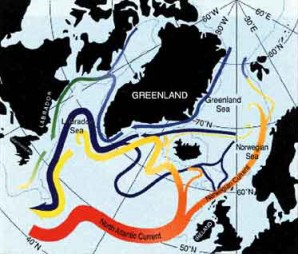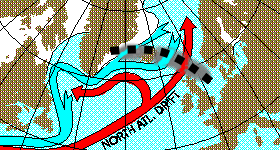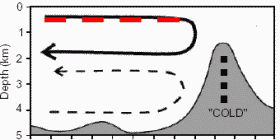 > ACCENT en > Climate Change classes 1 > 2 The Oceans > Background gulf stream
> ACCENT en > Climate Change classes 1 > 2 The Oceans > Background gulf stream
|
The Gulf Stream is not going to be disrupted... but what changes can be expected in the North Atlantic? |
|
The Gulf Stream is wind driven, the North Atlantic Drift is not The actual question is concerning the North Atlantic Drift, a Northern branch of the Gulf Stream. It is in particular responsible for the mild temperatures in Northwest Europe. The Gulf Stream is a wind driven ocean current. It cannot be disrupted simply by changes in the density of the water. |
|
Deep ocean water forms. This flows in deeper layers back towards the equator. In particular the turnover between Norway and Greenland has the consequence that warm surface water is carried relatively far to the North. The benefit for the West coast of Norway is a mild climate compared to other regions of the same latitude. |
|
Changes in the past We know from Studies of climate changes during the last 120,000 years, that there is a coupling between the formation of deep water in the North Atlantic and the change of the climate in this region. |
|
|
|
During the ice ages, as well as during the present warm time, an ocean current goes up to a certain limit to the north. The water penetrates slowly into cold regions and ice is formed. The remaining water bearing the ice becomes saltier and therefore heavier and due to the decreasing temperature in the polar region, the surface water also becomes heavier. Finally it sinks (black arrow downwards in the profiles) and forms 'deep water'. |
|
When is the North Atlantic Drift disrupted? |
|
While the ice is melting in a period of continuous warming (for example at the end of an ice age), too much fresh water from the molten ice can sometimes mix into the North Atlantic. Furthermore, the surface water becomes warmer, while the deep sea is still cold. The water cannot sink. In this case the ocean circulation may temporarily stop in the respective region. The circulation is temporarily disrupted. We call this a 'Heinrich event'. |
|
Estimations for the future (IPCC 2007) At present, scientists are not able to reliably forecast how the North Atlantic Drift is going to change under the conditions of climate change. It is expected that the current will slow down, since the surface water no longer gains so much density as before. The ocean surface becomes warmer, the ice formation less and the dilution by fresh water increases. Fresh water comes not only from the melting glaciers of the Greenland ice shield, but also from the increasing rainfall in this region. A density loss in the surface water has been observed over the period 1965 - 2000. On the other hand, the variation in the ocean stream over recent decades have been so strong and irregular, that there is no estimation possible of whether the water transport to the North might have been changing. |






